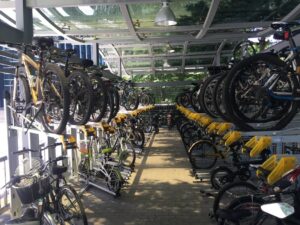
Top 5 Bicyle Parking Planning Mistakes
When it comes to bicycle parking, planners beware! There are a number of pitfalls you will want to try and avoid if you can. Through years of practice, I have encountered a number of issues with plans, some even being my own. So, be cautious, and if you can have a second set of eyes help out, take full advantage as some mistakes can be very costly!
Here are your top 5 bicycle parking planning mistakes.
1. PLANNING A BIKE LAYOUT WITHOUT BIKES IN THE RACKS
If you intend on creating a bicycle parking environment, you need to make sure you do your layouts with bikes. I can’t tell you how many times we have encountered planners using racks without bikes in them only to find that the rack styles they are using won’t fit.
Below is an example of a bike room that originally offered U Racks, one of the most popular style bikes racks on the market. The problem was that there weren’t any bikes in the racks. The spacing at first glance had looked like it would work, but we soon found out that we would only have 2’ of aisle space for commuters! #ouch

2. PLANNING A BIKE LAYOUT WITH THE WRONG BIKE RACKS
When planning your layout, you need to make sure the bike racks you are specifying are the right bike racks. There are several city ordinances that prohibit certain style bike racks, which could make your job a lot more stressful when you find out your bike racks are not an approved style bike rack.
It is strongly suggested you reach out to your cities bicycle parking ordinance division if you are a part of a new construction project in order to grab your cities current bicycle parking planning guide, if you have not already. Projects can be put on hold and sign off dates missed if you get it wrong. Below is an example of a a common bike rack this is not code compliant to meet city code in Sacramento, California.

If you are in need of help with your cities compliance, you can always contact Your Bicycle Parking Experts™ @bicycleparking.com. We can help!
3. PLANNING WITHOUT AMPLE WALKWAY OR LOADING SPACE
Many bike racks require ample walkway or loading space to rack your bike. It is always recommended to refer to your bicycle parking expert to insure spacing is correct. Many ground mounted bike racks require a minimum of 3’ of aisle space and a recommended 6’ of space behind the further most back bike tire.
As for vertical bike racks, it is recommended you have 6’ of aisle space, giving riders the ability to get their bikes on their back tire and maneuver into the vertical bike rack.
As with vertical bike racks, most double deck bike racks require at lest 6’ of loading space and some lift assist double deck bike racks could use 8

Not sure the space of the aisle space you need? You can always contact Your Bicycle Parking Experts™ @bicycleparking.com. We can help!
4. MOUNTING MISTAKES
There are several ways you can anchor or assemble a bike rack, from in ground mounting, concrete mount, free standing, asphalt, to earth anchoring plays an important role to the life of you parking product.
In-ground mount vs in ground surface mount. Many racks and site furnishings products offer installers to anchor an in-ground mount with a stinger, which will then act as a surface mount anchoring point. When this is the case, it is often better to just anchor into concrete, instead of boring a 12” hole and dropping a bike rack.

Concrete needs to cure. Make sure that if a pad is poured and a concrete anchoring option has been selected, make sure you do not anchor into green concrete. The outcome will not go over well with the rack owner.
Asphalt anchors. You should never anchor a concrete anchor into asphalt or pavement. Within days the pullout strength of the anchor will be void as pavement or asphalt both expand and contract with cold and warm weather, which opens the anchors hole. It is suggested you use a 10” or more anchor that comes with an epoxy that will allow you to anchor into pavement or asphalt and carry the same pullout strength as a concrete anchor. I suggest checking in with the team over at Bolt Hold for help with any pavement or asphalt installations.
For dirt, try to avoid a long rod/epoxy combo. These often fail unless attached to a large free-standing rack. It is best you purchase an in ground mount. This may take a little more time, but the safety and security will pay off! Need to know how to install an in ground bike rack? Check out the video below, courtesy of the team over at PVPC.
Not sure which mounting option you should use? You can always contact Your Bicycle Parking Experts™ @bicycleparking.com. We can help!
5. RUST TO FINISH
If you plan on purchasing a steel bike rack, beware! Depending on your location and proximity to salt, your bike rack could end up looking like a rusty mess.

If you are within a mile from the ocean, stainless steel is your best bet, followed by aluminum, then cold steel. If price is an issue, then galvanized/thermoplastic over your steel rack may stand a chance. If you are near salt (desalting areas), then may also want to opt for stainless or aluminium as your first choice, followed by galvanized thermoplastic as your second choice.
Not sure which finish you should use? You can always contact Your Bicycle Parking Experts™ @bicycleparking.com. We can help!
Thanks for tuning in, and remember, bicycle parking is our business!
Your friend,
Bike Parker




